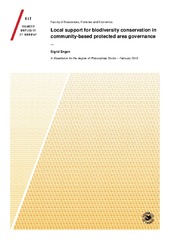Local support for biodiversity conservation in community-based protected area governance
Permanent link
https://hdl.handle.net/10037/12971View/
thesis (PDF)
Paper 1: Engen, S. & Hausner, V. (2017). Impact of local empowerment on conservation practices in a highly developed country. Also available in Conservation Letters,January/February 2018,11(1), 1–8. (PDF)
Paper 2: Engen, S., Runge, C., Brown, G., Fauchald, P., Nilsen, L. & Hausner, V. (2017). Assessing local acceptance of protected area management using public participation GIS (PPGIS). In press version. Published version available in Journal for Nature Conservation 43 (2018) 27-34 (PDF)
Engen, S., Fauchald, P. & Hausner, V. Conservation frames and the attitudes of stakeholders towards downgrading protected areas for economic development. Manuscript. (PDF)
Hausner, V., Engen, S., Bludd, E.K. & Yoccoz, N.G. (2017). Policy indicators for use in impact evaluations of protected area networks. Also available in Ecological indicators, 75, April 2017, 192-202. (PDF)
Date
2018-06-13Type
Doctoral thesisDoktorgradsavhandling
Author
Engen, SigridAbstract
Worldwide there have been many attempts to implement community-based conservation to gain a more inclusive protection of biological diversity. Reducing human pressures on ecosystems is necessary for favorable ecological outcomes of protected areas, but conservation initiatives that rely on strict enforcement without local support are vulnerable to rule-violations, public protests and a reduced political commitment. The Norwegian government decided in 2009 to employ a community-based conservation strategy for protected areas in Norway, and in this thesis I explore whether the reform has led to less local resistance towards conservation and reduced threats to biodiversity. Included are four studies that shed light on this main research question.
In this thesis, I investigate the strictness level of the current conservation policy and the local acceptance of spatially restricting resource use. I evaluate the impact of the Norwegian community-based conservation reform on the local decisions to regulate use, and analyze the views of conservation among local stakeholders.
This thesis shows that community-based conservation has accommodated local needs through a less strict conservation practice on private land. The local residents living near the protected areas seemed to accept the idea of restricting residential and industrial development inside protected areas, whereas a large proportion of key local stakeholders were less supportive of prioritizing conservation over economic development. The reform includes two governance bodies that are trusted by stakeholders holding different views of conservation, which suggests that local protected area boards along with stakeholder advisory councils could be in a good position to reconcile contrasting views of conservation.
The overall liberal conservation policy and practice makes it reasonable to question the impact protected areas have on reducing threats to biodiversity. The pressure for human activities is high in mountain areas and combined with a more lenient conservation practice this could reduce protected area effectiveness. Therefore I suggest that more attention should be devoted to the impact protected areas have on reducing human activities that pose a threat to biodiversity, compared with a situation without protection.
Publisher
UiT The Arctic University of NorwayUiT Norges arktiske universitet
Metadata
Show full item recordCollections
Copyright 2018 The Author(s)
The following license file are associated with this item:


 English
English norsk
norsk
